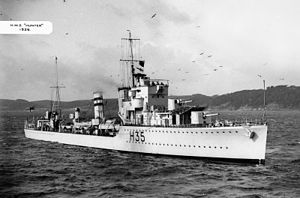
| |
| History | |
|---|---|
| Name | HMS Hunter |
| Ordered | 13 December 1934 |
| Builder | Swan Hunter, Tyne and Wear, United Kingdom |
| Cost | £253,167 |
| Laid down | 25 March 1935 |
| Launched | 25 February 1936 |
| Completed | 30 September 1936 |
| Identification | Pennant number: H35 |
| Fate | Sunk in the First Battle of Narvik, 10 April 1940 |
| General characteristics | |
| Class and type | H-class destroyer |
| Displacement | |
| Length | 323 ft (98.5 m) |
| Beam | 33 ft (10.1 m) |
| Draught | 12 ft 5 in (3.8 m) |
| Installed power |
|
| Propulsion | 2 shafts, geared steam turbines |
| Speed | 36 knots (67 km/h; 41 mph) |
| Range | 5,530 nmi (10,240 km; 6,360 mi) at 15 knots (28 km/h; 17 mph) |
| Complement | 137 (peacetime), 146 (wartime) |
| Sensors and processing systems | ASDIC |
| Armament |
|
HMS Hunter was a H-class destroyer built for the Royal Navy in the mid-1930s. During the Spanish Civil War of 1936–1939 the ship enforced the arms blockade imposed on both sides by Britain and France, until she struck a mine in May 1937. She was under repair for the next year and a half, after which she rejoined the Mediterranean Fleet. During the first few months of the Second World War, Hunter searched for German commerce raiders in the Atlantic Ocean until she was transferred back to Britain in February 1940. Returning to action in the Norwegian Campaign, she was sunk by German destroyers during the First Battle of Narvik in April 1940.